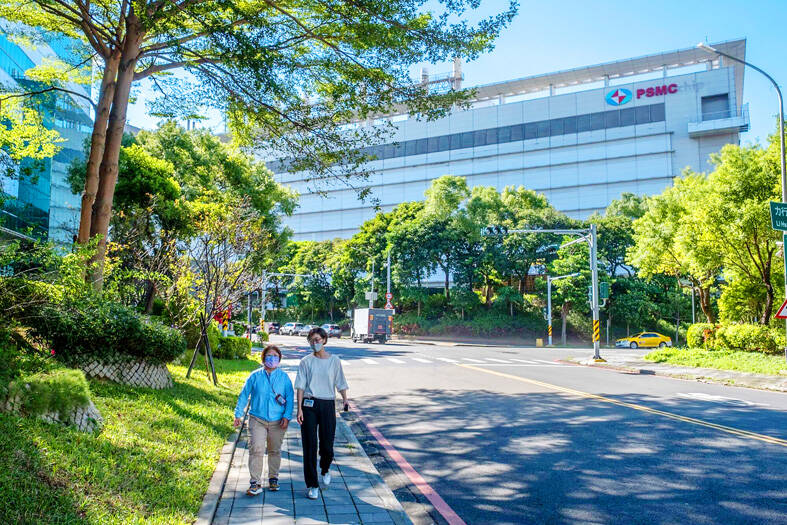Powerchip Semiconductor Manufacturing Corp (力積電) yesterday reported that its net losses last quarter shrank 79.2 percent from the previous quarter, reflecting improving gross margin as the company’s factory utilization increased and the cost of idle capacity was reduced.
Net losses in the January-to-March period totaled NT$439 million (US$13.56 million), compared with losses of NT$2.11 billion during the previous three months, the pure-play wafer foundry firm said in a document released after the company’s earnings conference.
Last quarter, Powerchip’s revenue fell 3.06 percent to NT$10.82 billion during the industry’s low season, compared with NT$11.16 billion the previous quarter, the company said.

Photo: Lam Yik Fei, Bloomberg
However, gross margin improved by 12.3 percentage points to 15.4 percent, while operating margin was minus-9.9 percent, better than the minus-18.1 percent recorded in the previous quarter, it said.
Last quarter’s net losses translated into losses per share of NT$0.11, compared with losses per share of NT$0.52 the previous quarter, company data showed. The result was roughly in line with market estimates of losses per share of NT$0.1.
However, Powerchip’s top-line and bottom-line results in the first quarter were still lower than the same period last year, with revenue down 5.49 percent and net profit plunging 335 percent due to softening end-market demand and its customers’ continued inventory adjustments, it said.
Powerchip, which makes DRAM and flash chips, as well as power management and driver ICs, on a contract basis, said the massive earthquake that hit Taiwan’s east coast on April 3 would affect its second-quarter shipments by 5 to 8 percent.
The quake measured 7.2 on the Richter scale and magnitude 7.4 on the moment magnitude scale.
The company said the recovery rate of its production lines reached 80 percent within three days of the earthquake and 95 percent within one week.
It hopes 50 to 60 percent of its quake losses — such as scrapped chips and damaged components — would be covered by insurance, Powerchip said.
For this quarter, average selling prices of memory products are expected to climb as end-market demand rises and customers face less inventory pressure, while prices of discrete components and power management ICs could remain stable, it said.
However, prices of CMOS image sensors and small-size display driver ICs, which accounted for about 20 percent of the company's revenue, would face competition from Chinese rivals, making it a key variable affecting the company's profitability, Powerchip said.
Overall, it is cautiously positive about its revenue performance this quarter and expects gross margin to be flat or higher than last quarter, driven by improving factory utilization for logic chip and memorychip operations, the company said.
Powerchip said it has raised its capital expenditure this year to NT$32 billion from an earlier budget of NT$24 billion, as it is adjusting its product mix to cope with market changes and customers’ needs as well as respond to inflation-driven equipment cost increases.

SELL-OFF: Investors expect tariff-driven volatility as the local boarse reopens today, while analysts say government support and solid fundamentals would steady sentiment Local investors are bracing for a sharp market downturn today as the nation’s financial markets resume trading following a two-day closure for national holidays before the weekend, with sentiment rattled by US President Donald Trump’s sweeping tariff announcement. Trump’s unveiling of new “reciprocal tariffs” on Wednesday triggered a sell-off in global markets, with the FTSE Taiwan Index Futures — a benchmark for Taiwanese equities traded in Singapore — tumbling 9.2 percent over the past two sessions. Meanwhile, the American depositary receipts (ADRs) of Taiwan Semiconductor Manufacturing Co (TSMC, 台積電), the most heavily weighted stock on the TAIEX, plunged 13.8 percent in

A wave of stop-loss selling and panic selling hit Taiwan's stock market at its opening today, with the weighted index plunging 2,086 points — a drop of more than 9.7 percent — marking the largest intraday point and percentage loss on record. The index bottomed out at 19,212.02, while futures were locked limit-down, with more than 1,000 stocks hitting their daily drop limit. Three heavyweight stocks — Taiwan Semiconductor Manufacturing Co (TSMC, 台積電), Hon Hai Precision Industry Co (Foxconn, 鴻海精密) and MediaTek (聯發科) — hit their limit-down prices as soon as the market opened, falling to NT$848 (US$25.54), NT$138.5 and NT$1,295 respectively. TSMC's

In a small town in Paraguay, a showdown is brewing between traditional producers of yerba mate, a bitter herbal tea popular across South America, and miners of a shinier treasure: gold. A rush for the precious metal is pitting mate growers and indigenous groups against the expanding operations of small-scale miners who, until recently, were their neighbors, not nemeses. “They [the miners] have destroyed everything... The canals, springs, swamps,” said Vidal Britez, president of the Yerba Mate Producers’ Association of the town of Paso Yobai, about 210km east of capital Asuncion. “You can see the pollution from the dead fish.

TARIFFS: The global ‘panic atmosphere remains strong,’ and foreign investors have continued to sell their holdings since the start of the year, the Ministry of Finance said The government yesterday authorized the activation of its NT$500 billion (US$15.15 billion) National Stabilization Fund (NSF) to prop up the local stock market after two days of sharp falls in reaction to US President Donald Trump’s new import tariffs. The Ministry of Finance said in a statement after the market close that the steering committee of the fund had been given the go-ahead to intervene in the market to bolster Taiwanese shares in a time of crisis. The fund has been authorized to use its assets “to carry out market stabilization tasks as appropriate to maintain the stability of Taiwan’s